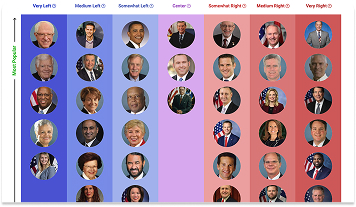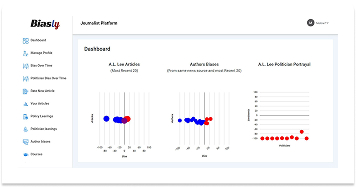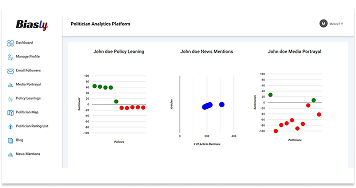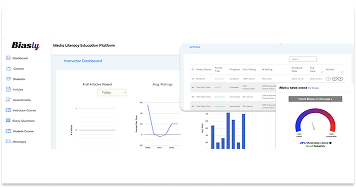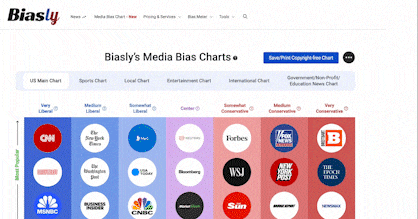Bias Meter
Extremely
Liberal
Very
Liberal
Somewhat Liberal
Center
Somewhat Conservative
Very
Conservative
Extremely
Conservative
-100%
Liberal
100%
Conservative

Biasly determines media bias ratings through a dual-layered approach combining artificial intelligence and analyst review. The platform’s proprietary bias detection engine, Bias Meter, evaluates sentiment, policy position alignment, and language framing across thousands of data points in news articles. Analysts then verify and interpret the AI’s findings, providing additional context where needed. Learn more
- Profile
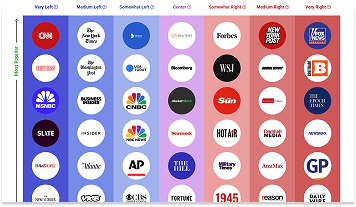
POLITICO on the media bias chart
POLITICO has a Bias Score of -30% Somewhat Left which is based on a variety of factors including its policy and politician leanings, article ratings, and the use of biased language. Its Reliability is rated as Good, and additional analytical insights are available in the other tabs.
- Bias Rating
-30% Somewhat Left
- ReliabilityPolicy Leanings
-2% Center
Extremely
LiberalVery
LiberalModerately
LiberalSomewhat Liberal
Center
Somewhat Conservative
Moderately
ConservativeVery
ConservativeExtremely
Conservative-100%
Liberal100%
Conservative
Average Reliability
*Our bias meter rating uses data science including sentiment analysis, machine learning and our proprietary algorithm for determining biases in news articles. Bias scores are on a scale of -100% to 100% with higher negative scores being more liberal and higher positive scores being more conservative and 0% being neutral. The rating is an independent analysis and is not affiliated nor sponsored by the news source or any other organization.
Politician Portrayal90% negative
Continue For Free
Create your free account to see the in-depth bias analytics and more.
By creating an account, you agree to our Terms and Privacy Policy, and subscribe to email updates.
Policy Leanings Analysis
Policy | Bias score |
|---|
POLITICO Editorial Patterns
POLITICO’s coverage of political topics often reflects a Somewhat Left bias, with consistent patterns in phrasing, source selection, and thematic focus that is Lean Left. While the publication demonstrates journalistic standards in many of its reports, the choice of issues, framing, and word usage can indicate a political slant. This content analysis examines how POLITICO handles liberal and conservative issues and evaluates its language choices and editorial tendencies.
Coverage of Liberal vs. Conservative Topics
POLITICO prides itself on its policy coverage and, as a result, does not often focus on social issues. Still, there do seem to be inconsistencies when covering liberal and conservative topics. Topics such as healthcare, tax, and education receive extensive coverage. However, topics such as energy, transportation, and labor receive minimal coverage.
One of POLITICO’s main challenges is providing equal coverage of liberal and conservative topics. Much of what POLITICO covers is about conservative politics, such can be seen in the “Congress” section on their website. The majority of articles in this section relate to conservative members of Congress. One might argue that this is due to Republicans’ control of Congress. However, the majority of the articles presented there are not related to voting on bills, but rather about statements made by members of Congress.
Policy and Issue Framing
The framing of major issues is inconsistent. Often, the more POLITICO covers a topic, such as healthcare, the more biased it will be. POLITICO typically frames liberal issues in a more critical light. They will provide mixed framing of conservative issues, with some being neutral, critical, or supportive.
Take, for example, this article covering Secretary of Health and Human Services Robert F. Kennedy Jr.’s “Make America Healthy Again” platform. The piece provides mixed framing, portraying RFK Jr.’s efforts as effective throughout the states, associating his platform as a direct cause for health movements in the states. However, the article gives credit to many Democratic-leaning states for “leading the charge.”
Liberal topics covered by POLITICO tend to be more critical of them. They will tend to point out failures in policy or execution. Take, for example, this article covering California, a liberal state, that attempts and fails to create lasting clean energy. This style appears in many other pieces covering liberal issues, particularly those related to the Democratic Party, such as this article. The articles are generally factual and provide extensive coverage, but they provide a negative tone.
Tone in articles covering conservative topics tends to be more mixed. One such example is this article covering President Donald Trump’s views on mail-in ballots. The article presents a critical tone, criticizing Trump’s contradictions with some of his previous statements about mail-in ballots. Still, another article that discusses trade relations with allies provides a more neutral tone on the Trump Administration.
Even in otherwise neutral coverage, subtle phrasing choices can still shape perception. Some articles might use words such as “reconciliating” to describe Trump’s policies, which could signify a right-leaning bias.
Coverage and Relevance
POLITICO’s reporting often touches on key issues central to the media political bias discussion — including newspaper bias, bias in journalism, and biased media narratives. As such, it serves as a compelling case study for examining source bias and news media bias in state-focused reporting.
Readers who wish to further explore how POLITICO compares with other publications can visit Biasly’s Media Bias Chart to analyze tone and word choice in real time.
POLITICO Bias Analysis
POLITICO began as one of the first online news sources in 2007. While most sources were designed to inform the public on policy developments, POLITICO takes a different stance. Their vision states that they intend to inform the powerful and influential, such as politicians and investors.
A YouGov poll gauged the amount of trust that the American public had in various news sources, such as POLITICO. In response to “How trustworthy is news from POLITICO?,” the poll found that people were more likely to trust POLITICO than distrust.
Because this source is online, it is challenging to identify the underlying factors that may influence bias. We might look at significant figures in POLITICO, such as co-founder Jim VandeHei. Vandehei would later found Axios, an online news source which Biasly’s Media Bias Chart rates as “Somewhat Left.” Co-founder John F. Harris wrote a biography of former President Bill Clinton. Harris and VandeHei worked for the Washington Post, rated “Somewhat Left” by Biasly’s Media Bias Chart, before founding POLITICO
A Pew Research Center poll asked regular readers of major news outlets, POLITICO among them, about how they identify along party lines. This poll found that regular readers of POLITICO identified themselves similarly to readers of the New York Times, Associated Press, PBS, and MSNBC. All of these outlets are rated “Somewhat Left” by Biasly’s Media Bias Chart.
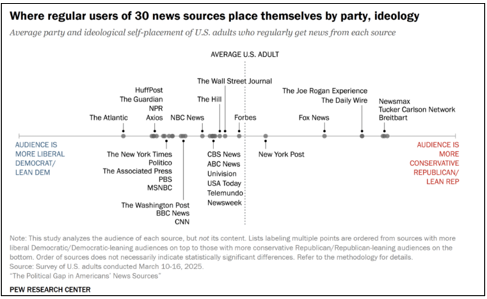
Source: Pew Research
To properly analyze bias, however, we must analyze articles. The following sections analyze indicators of bias in POLITICO’s reports and opinion pieces.
Is POLITICO Biased?
Based on Biasly’s evaluations, POLITICO is rated as Somewhat Left.
By examining content patterns and the broader context of media influence, we aim to offer a balanced perspective on POLITICO’s political bias—and contribute to the ongoing discussion about bias in the news.
How Does Biasly Rate News Sources?
Biasly uses proprietary algorithms and a team of analysts to provide comprehensive bias evaluations across thousands of news outlets. Over 200,000 articles from more than 3,200 sources have been analyzed to identify the most accurate and unbiased stories.
Biasly assigns each outlet three key scores:
- Reliability Score – Reflects factual accuracy
- AI Bias Score – Generated via natural language processing
- Analyst Bias Score – Assessed by human political analysts
These scores are based on seven core metrics: Tone, Tendency, Diction, Author Check, Selection/Omission, Expediency Bias, and Accuracy. These elements help analysts and algorithms evaluate the political attitude conveyed by each article.
Biasly’s Bias Meter ranges from -100% (most left) to +100% (most right), with 0% indicating neutrality. The system evaluates individual articles based on political terms, policies, figures, and sentiment to calculate precise bias ratings.
Is POLITICO Politically Biased?
POLITICO earns a Somewhat Left rating for its AI Bias Score and a Somewhat Left for its Analyst Bias Score. The Analyst Bias Score is generated by reviewers from liberal, moderate, and conservative backgrounds. Analysts reviewed 15 POLITICO articles and found conservative bias on topics such as healthcare and liberal policy. However, the paper maintained objectivity on topics like education and trade.
For example, some articles discussing healthcare may present a supportive tone for RFK Jr.’s policies, but a negative tone towards right-leaning healthcare policies. Further, they sometimes cover RFK Jr.’s views on vaccinations, with a largely neutral tone.
Analysis of Bias in POLITICO Online Articles
POLITICO has found in-depth coverage of the White House and Congress. Many of their articles cover actions taken by the White House or debates in Congress. The key question remains: is %SOURCE_NAME% politically biased?
To evaluate this, we can analyze select POLITICO articles through several of Biasly’s bias rating criteria: Tone, Tendency, Author, Diction, and Expediency Bias.
- Tone: Emotions conveyed in the article
- Diction: Vocabulary used in the article
- Author: History and trend of the writer
- Tendency: Patterns or trends that the writer’s other works follow
- Expediency Bias: Images or phrases that are meant to catch the reader’s attention

Source: POLITICO
One such example of potential bias in this article is regarding Trump’s bid for a Nobel Peace Prize for his diplomatic efforts. Some sections in the article present a critique of the president. Others offer recognition of the president’s accomplishments. The article provides inconsistent bias, which itself might be a sign of neutrality.
First, let us analyze the title and featured photo in the article for expediency bias. The title suggests bias by labeling Trump a ‘kingmaker’. The article would later cite the title to a White House staff member who preferred to remain anonymous. ‘Kingmaker’ might imply a left-leaning bias, as it provides a negative connotation for Trump. The featured image might also be a sign of left-leaning bias, as it shows Trump in a rather unflattering image. However, whether that is the intent is unverifiable.
Next, let us analyze the diction used. The article generally avoids biased language, opting instead for neutral words. Such words as “questions” are used when referring to statements made by Trump’s opposition. Certain words, such as “relishes” and “kingmaker,” might imply a left-leaning bias, as they depict Trump as someone solely interested in building a reputation. However, those words were reportedly said by an anonymous source in the White House.
The tone of the article also presents an unclear bias. While the article generally presents a factual and neutral tone, certain segments might signify an anti-Trump bias. Notably, the article questions Trump’s motives for the peace negotiations, arguing that he might only be involved for the prestige that comes with them. They cite foreign leaders involved in the arrangements, stating that some only nominated Trump for the prize to curry favor with him. This tone presents a negative and egocentric view of Trump. However, presenting this tone is not a guarantee of bias, as they can be inherently factual and not intended for a negative interpretation of Trump.
The author frequently calls into question Trump’s impact on these peace deals. He uses sources such as John Bolton, former National Security Advisor under Trump, and now a staunch Trump opponent. He quotes Bolton arguing that Trump has limited involvement in most of these peace agreements, and some have follow-through days after they were brokered. The article also shows skepticism, noting the White House’s reluctance to release details about Trump’s role.
This article was written by Jake Traylor, who is a White House reporter for POLITICO. Looking at his professional history, we see that Traylor has previously worked for NBC, which Biasly’s Media Bias Chart rates as “Somewhat Left.” He has also worked as an intern at Fox News, which Biasly Media Bias Chart rates as “Medium Right.” Traylor graduated from Texas A&M University. The Texas A&M System, its on-campus news organization, published an article that seems to boast of its position as one of the most conservative universities in America. The article cited Niche, an in-depth college analysis site, which claimed that A&M was one of the most conservative universities. A 2025 update of Niche’s rankings places A&M as the 10th most conservative university. Traylor has also worked as the president of Texas Future Farmers of America, a nonprofit organization designed to promote agriculture education to middle and high schools. Future Farmers of America is bipartisan, and their alumni include politicians from both parties.
Jake Traylor does not have a significant social media presence. Analyzing his X, formerly Twitter, account shows mostly posts about his work following the 2024 campaign trail. He posted videos and images of Kamala Harris and Trump rallies, with no sign of bias in the posts. His banner shows a picture of him interviewing Trump, but this is unlikely to be an indicator of bias. He also posted in the late 2010s about Christianity and his faith in Jesus.
POLITICO published an article covering topics “Trump would rather talk about than Jeffery Epstein.” This article is an interactive of topics Trump has talked or posted on social media following the controversial statements by the FBI that there are no comprehensive logs relating to notorious sex offender Epstein. The article provides a mocking tone of Trump’s alleged attempts to draw attention away from the Epstein files. The list is contained in graphics of file cabinets, designed to mock the Epstein files. The article uses potentially biased language, such as “flood” and “onslaught,” to describe Trump’s frequent posts. While these words are technically accurate, they provide a negative and destructive connotation.
A previously mentioned article describing RFK Jr.’s platform may be a sign of right-leaning bias. While the article does not directly praise the Trump Administration, it offers a praising tone for RFK Jr. for his efforts across the states. While his efforts have certainly caught attention in many states, the article seems to give more credit to RFK Jr. than perhaps deserved. The article fails to provide evidence that RFK Jr. is directly responsible. It uses a map detailing the number of bills proposed addressing issues that were popularized by RFK Jr.’s platform. However, the issue is that the states that introduced the most bills are states that are unconnected to RFK Jr. or are already known for health regulation.
The article’s map of states that introduced the most bills popularized by RFK Jr.’s platform shows that states such as Texas, Minnesota, New York, and Massachusetts introduced the most bills. However, a study from the Commonwealth Fund states that most of these states already have extensive state-sponsored healthcare systems in place. It is more likely that these states introduced bills because they already have extensive healthcare systems and regulations, not due to the direct efforts of RFK Jr.
This is further supported by a statement from the article stating that RFK Jr. has already visited multiple states on a tour. This tour is designed to promote his platform, but the states he toured do not have a significant number of bills introduced. Thus, it is likely RFK Jr. did not have a significant impact on the bills introduced. The article gives unearned credence to RFK Jr, potentially showing a right-leaning bias.
To sum it up, POLITICO shows inconsistent bias across its reporting. Some reports provide neutral coverage, such as the article covering Trump’s peace deals. Other articles, such as the one discussing topics Trump has discussed following the Epstein controversy development, present a mocking tone and are critical of Trump. However, some articles also provide more credit than perhaps deserved to the Trump administration’s efforts, such as the article covering RFK Jr.’s platform.
Analysis of POLITICO Opinion Articles
To fully understand political bias in media, it’s important to distinguish between factual reporting and opinion pieces. While reporting aims to present facts and let readers form their own conclusions, opinion articles express personal viewpoints on current issues. Although the previous section examined factual reporting, this section turns to how bias surfaces through POLITICO’s selection and tone of opinion content.
One example of an opinion article is this article published in the POLITICO Playbook, a frequently updated subscription newsletter. The article, published during the 2021 attempt to impeach Trump, provides a critical view of the House members seeking to impeach Trump. The article is written by conservative influencer Ben Shapiro, who is also an editor at the Daily Wire, which Biasly’s Media Bias Chart rates as “Medium Right.”
The article itself criticizes House Republicans who decided to vote in favor of Trump’s impeachment, and offers support for Republicans who voted against the impeachment. The article spreads the conservative theory that Democrats were deliberately trying to repress conservative ideology, and cites statements made by two members of Congress.
Other opinion articles, such as this one that promotes open confrontation between Europe and Russia. The article takes a critical stance on Trump’s non-confrontational approach to mediating the Russo-Ukrainian War. It mocks the leadership of the European Union for being subservient and submissive to Trump. This article presents a pro-Ukraine lean and anti-Trump beliefs. Thus, the article presents a left-leaning bias.
This tendency highlights the importance of distinguishing between subjective viewpoints and straightforward reporting, particularly when evaluating the political leanings of any news organization.
Who Owns POLITICO?
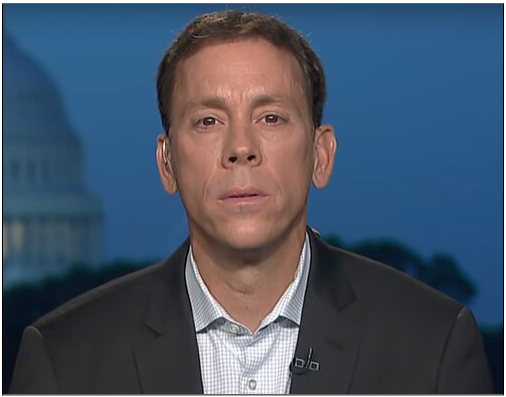
Source: Wikipedia
POLITICO was founded in 2007 by editors John F. Harris and Jim VandeHei. They were financially backed by Robert L. Allbritton, who later created POLITICO’s parent company, Capitol News Company. This company would later be bought by Axel Springer SE, a German multimedia news company. Axel Springer SE’s CEO and chairman of their board is Mathias Döpfner.
The current CEO of POLITICO is Goli Sheikholeslami. She has previously served as the CEO of New York Public Radio and held various leadership roles for the Washington Post, Chicago Public Media, Condé Nast, and Time Warner. She has previously been on the board of NPR and is currently on the board of Patreon.
The stated vision for POLITICO is perhaps their most unique element. Most news sources state that they wish to bring responsible and factual news coverage to the people. But, POLITICO’s “About Us” page states a different target audience. POLITICO states that their vision is to bring factual news coverage to the powerful, such as politicians, the rich, or other significant leaders. Therefore, it seems they wish to inform the influential rather than the everyday person.
Who Funds POLITICO?
POLITICO operates as a for-profit outlet and is primarily funded through a combination of digital advertising, subscriptions, events, and its highly lucrative POLITICO Pro service. POLITICO Pro, its specialized policy intelligence platform, sells premium access to legislative analysis, regulatory tracking, and insider reporting to government agencies, Fortune 500 companies, lobbyists, and advocacy organizations. This subscription model represents a major revenue stream and reinforces POLITICO’s stated mission to serve influential decision-makers.
The organization also earns substantial income through political and policy-focused conferences, sponsorships, and branded events. While these funding sources do not directly control editorial decisions, they create an incentive for POLITICO to maintain strong relationships with policymakers, corporations, and industry groups who purchase Pro subscriptions or sponsor events. This dynamic can raise questions about whether coverage may be shaped, subtly or indirectly, by the interests of its most valuable institutional clients.
Overall, POLITICO’s revenue model relies on providing high-quality, insider political reporting to elite audiences rather than a broad public readership. While this does not necessarily result in partisan bias, it can influence story selection and framing toward issues that matter most to political professionals, lobbyists, and major corporations that fund its operations.
How to Evaluate Bias
Although Biasly rates POLITICO as Somewhat Left, it’s important to remember that bias can vary from article to article. POLITICO also covers a conservative-leaning state with objectivity on many issues, from state legislation to social developments. This complexity underscores the importance of examining each article individually. So, let’s learn how to evaluate media bias.
Recognizing media bias requires awareness and critical thinking. Often, readers trust news sources that affirm their existing beliefs—a psychological tendency known as confirmation bias. This makes it harder to identify slanted narratives or one-sided reporting.
To combat this, it’s essential to challenge your assumptions by consulting multiple viewpoints and verifying news through third-party analysis. Tools like Biasly’s media bias ratings allow readers to compare the same news story across the political spectrum.
Ultimately, bias isn’t always a matter of what is said—it’s also about what is left out, how topics are framed, and which stories are chosen for coverage. Learning to recognize these patterns can help readers make more informed decisions and develop greater media literacy.
To start comparing news outlets and gain a better understanding of bias, sign up for Biasly’s Media Bias & News Analytics Platform to see how stories vary between sources.
POLITICO Reliability Analysis
Is POLITICO Reliable?
POLITICO finds itself toward the middle of the spectrum, with neither high nor low accuracy. POLITICO holds a decent position of trust among Americans, as the previously mentioned YouGov poll on trust found. This may be indicative of high reliability, but that is not definitive.
Further investigation is needed to determine whether bias or other factors are affecting its accuracy. At Biasly, we specialize in evaluating not just bias but also the reliability of media outlets. Let’s explore the accuracy and trustworthiness of POLITICO.
How to Evaluate Reliability?
Reliability refers to how trustworthy or accurate a news source is. If we can’t trust what we read, then continuing to consume content from that outlet serves little purpose. So how do we evaluate a news outlet’s reliability?
There are several potential measures of reliability to look out for when trying to determine whether a media source is reliable or not. Red flags for an unreliable article can include the presence of wild, unsubstantiated claims, facts dependent on other unreliable sources, heavy use of opinionated language, and more. In contrast, hallmarks of a reliable source include:
- Absence of subjective language
- Citing credible sources (e.g., .gov, .edu, academic references)
- Verifiable facts and statistics from multiple outlets
- Use of primary sources, like interviews or transcripts
- Consistency with coverage across other platforms
Biasly’s reliability scores incorporate these elements in evaluating media outlets.
So How Does POLITICO Fare in Its Reliability?
The political reliability index developed by Biasly assesses both accuracy and trustworthiness. POLITICO currently holds Good Reliability Score, which is calculated as a weighted average of:
- Fact Analysis Score – Evaluates the accuracy of claims, facts, and evidence.
- Source Analysis Score – Assesses the number, diversity, and credibility of sources and quotes used.
POLITICO’s Source Analysis Score is Average at 55% Reliable. This suggests moderate trustworthiness in its sourcing practices. The score is AI-generated and considers quote length, frequency, diversity, and quality.
The Fact Analysis Score of POLITICO is Good at 89% Reliable. This further shows how well POLITICO supports its claims, addresses selection and omission bias, and presents verifiable evidence.
While POLITICO leans toward factual reporting, occasional lapses—such as unbalanced viewpoints or incomplete data—can affect its reliability rating. These nuances emphasize the importance of analyzing individual articles.
POLITICO’s Accuracy and Reliability
According to Biasly’s analysis, POLITICO maintains Good Reliability Score, but individual articles may vary significantly. Let’s dive into the details.
Political orientation plays a crucial role in how audiences perceive reliability. POLITICO has been accused of favoring a liberal narrative, potentially at the expense of factual reporting. To validate such claims, it’s essential to analyze whether the publication backs its assertions with sufficient evidence and diverse viewpoints.
Two common types of bias that affect factuality include:
- Selection Bias – Highlighting or omitting stories to fit a particular narrative.
- Omission Bias – Leaving out differing perspectives or relevant details to skew perception.
Biasly’s accuracy ratings use a scale from 1% (least accurate) to 100% (most accurate). Factors include the presence of supporting evidence, internal and external reliable sources, and balanced viewpoints.
For instance, let us look at Biasly’s rating of the New York Times, which is rated as “Somewhat Left” by Biasly’s Media Bias Chart. Biasly justifies its rating by citing this article, among others, as an example of bias and reliability. The article overwhelmingly is negative of Trump, as it consistently states that Trump’s theories and beliefs around the 2020 presidential election are lies and unfounded. While this is factually correct, as no credible evidence has been presented regarding widespread fraud, the way this is presented is the biased part. The article provides a negative portrayal of Trump and his supporters, and provides support for Republicans who go against Trump. This is illustrated in the following quote:
“But now she finds herself at odds with a party whose leader is silent in the press but still a fan favorite among the party faithful. ‘A guy who got 47 percent is not the future of our party,’ Comstock said, referring to Trump’s total in the 2020 election. ‘The toxic personality divided our country and is now dividing our party.’”
We will take a closer look at more examples like this below to provide a further investigation into the reliability of POLITICO’s articles. This will include its use of selection bias, omission bias, and the quality of its sources and the facts it uses.
Analysis of Reliability in POLITICO’s Online News Articles
POLITICO aims to serve Utahans with objective, fact-based reporting. Its staff includes writers from varying ideological backgrounds, which can help balance coverage. However, readers should distinguish between news reporting and opinion pieces to evaluate credibility effectively.
One notable example is the article titled “Mike Lee says he wants to stop noncitizens immigrants from voting – but has no evidence they are.” Reporter Bryan Schott covered Senator Mike Lee’s claims while referencing past debates and legal records. The article refrains from editorial commentary, sticking to quotes and fact-based language. Despite POLITICO’s Somewhat Left rating, this piece illustrates factual neutrality.
Quality of Sources and Facts Used
POLITICO often uses credible sources from across the political spectrum.
For an example of the quality of sources and facts, we will analyze this article published by POLITICO. The article uses a variety of credible sources for the facts used.
Direct quotes are one of the best ways of displaying reliability, as they display the source’s words as they are, without filter. We will divide direct quotes into two forms: short-form quotes and long-form quotes. Short form quotes have few words or display key phrases or terms. Long-form quotes will be longer quotes and are typically uninterrupted.
This article does a good job of displaying direct quotes, with 9 short-form quotes and 10 long-form quotes. The quotes vary in length, but generally come from credible and relevant sources.
Next, we shall look at the sources displayed in the article and evaluate them for bias and credibility. Following is the complete list of sources in the article.
- 2016 Trump Campaign, statements and slogans used by the campaign
- Other POLITICO Articles
- CGCN, a lobbying group that hired a former Trump staffer
- Tether, a company that hired a former Trump staffer
- CBS News, a news outlet that Biasly has ranked as “Somewhat Left”
- Ivan Adler, owns a company dedicated to identifying lobbyists
- Susie Wiles, Chief of Staff at the White House
- Kedric Payne, leads an ethics program at the Campaign Legal Center
- Anonymous White House official
- Harrison Fields, the White House staffer who left for a position at CGCN
- Axios, a news outlet that Biasly has ranked as “Somewhat Left”
- Karoline Leavitt, White House press secretary
- Matt Rhoades, Managing Partner at CGCN
The article uses relevant and credible sources for most of the facts presented. Because the article pertains to the White House, the article reasonably uses numerous White House sources. Other sources, such as the company hiring the former staffers, are also reliable, as they are directly involved in the situation. Axios and CBS may have questionable reliability, as both are rated as left-leaning news sources. However, these sources play a minor role in the article and are thus unlikely to be an indicator of bias.
The sources and facts in the article are generally reliable and credible. The article does not show significant bias towards any direction. They reasonably use sources from the White House as statements and use articles from left-leaning outlets to cover relevant topics.
Selection and Omission Bias
POLITICO provides extensive coverage of political events in the United States. But quality coverage may be harmed by selection and omission bias. Selection and omission bias are uniquely difficult to spot. If a reader does not read articles from other sources on the same topic, they cannot easily detect what is missing. This makes it important to analyze potential selection and omission bias.
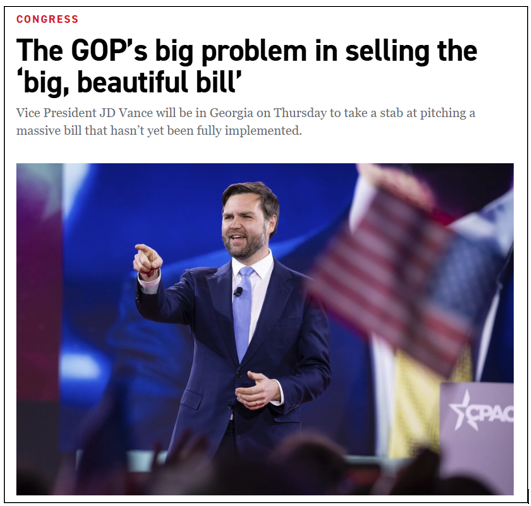
Source: POLITICO
Take this article covering Republicans’ efforts to promote the “big, beautiful bill” to their constituents. The article provides extensive coverage of Republicans’ efforts to promote the bill, and occasionally covers Democrats’ pushback on the bill. The article notably highlights efforts from Republicans around the country to promote the bill while not giving equal attention to pushback.
The article provides extensive coverage of Republicans’ efforts compared to Democrats’ pushback, which may be an example of omission bias. While the article provides some quotes from Democrats who oppose the bill, the quotes are short and infrequent. In short, the article does not give equal representation to the opponents of the bill as they do to the proponents.
Further, the article gives Republicans the benefit of the doubt, allowing them to justify potential delays in when voters will receive benefits for the bill. This can be seen in the following passage, which may lead readers to believe that there will be benefits to come.
“But the GOP megabill is less than two months old, and many of its purported boons — like new and expanded tax cuts and savings accounts for children under 18 — won’t be fully felt by voters until 2026, making it harder for Republicans to reinforce what they see as the law’s advantages.”
Comparatively, the article provides little coverage of the Democrats’ voices on this matter. The following passage is the only criticism of the bill by Democrats that was presented in the article.
“‘House Republicans have betrayed their constituents in passing the Big, Ugly Law, which benefits the wealthiest few and leaves everyday families behind,’ Democratic Congressional Campaign Committee Chair Suzan DelBene (Wash.) said in a statement Wednesday.”
The first passage presents a positive view of the bill, which highlights certain aspects of the bill that would potentially benefit the public. The second passage, however, only presents a brief, quoted statement from a Democrat and does not highlight any aspects of the bill.
Although these quotes may initially appear equally representative, the level of detail shows a clear imbalance. The first quote gives details that support the bill, but the second quote does not provide any details that left-leaning people have argued. According to this article by CNN, which Biasly has ranked as “Very Left,” left-leaning people have presented arguments against aspects of the bill. No arguments opposing aspects of the bill are presented in the POLITICO article.
In opinion pieces, issues with factuality, sources, selection, and omission are frequently present. The articles we’ve covered so far reflect POLITICO’s Somewhat Left views, but this is not detrimental to its reliability. Its story selection favors issues that are more likely to concern liberals, making it safe to assume it neglects issues within Utah that concern conservatives. However, the contents of POLITICO’s article maintain accuracy and tend to cite evidence from numerous and varied sources.
So, Is POLITICO Reliable?
Overall, POLITICO can be considered to be an outlet that is very reliable. It demonstrates a commitment to journalistic integrity and usually supports claims with credible sources and quotes. Occasional omissions and framing bias do appear, particularly on culturally sensitive or partisan issues.
As media literacy improves, readers can more easily detect issues with selection bias, omission bias, and factuality. To strengthen your ability to assess reliability across the political spectrum, use the News Bias Checker to compare how multiple outlets report the same story.
This empowers you to consume more accurate, balanced, and dependable news.
Additional Insights
News Source Comparison
When it comes to news source comparison, POLITICO is often evaluated alongside other online news outlets. Sources like The Hill, Axios, and Vox are most frequently compared to POLITICO, as they are all primarily online. Biasly’s Media Bias Chart has rated Axios as rated as “Somewhat Left,” Vox as “Medium Left,” and The Hill as “Center.”
POLITICO is also frequently compared to sources such as the New York Times, PBS, MSNBC, and AP. A previously mentioned Pew Research poll found that regular readers of these outlets self-identify similarly politically as regular readers of POLITICO.
Notable Contributors and Authors
POLITICO has had some notable contributors write for them. One such contributor is conservative podcast host Ben Shapiro, who Biasly’s Journalist Bias Analysis rates as “Very Right.” POLITICO published an article by Shapiro to the POLITICO Playbook, an email subscription service describing political news. POLITICO received pushback for publishing Shapiro’s article. Still, editor-in-chief Matthew Kaminsk refused to take down the story, stating that POLITICO “stands by every word” in the article.
Related Tools and Resource Pages
To better understand how POLITICO fits into the broader media landscape, we recommend exploring these helpful resources:
- Media Bias Chart: See where POLITICO ranks among hundreds of media outlets across the political spectrum.
- Political Bias Chart: Visualize political slants of news sources across various policy areas.
- Journalist Bias Analytics Platform: Explore how individual journalists contribute to bias within their publications.
- Politician Bias Analytics Platform: Compare how politicians are framed differently by POLITICO and other outlets.
- Media Literacy Education Platform: Learn how to critically assess media sources, bias techniques, and news reliability.
Frequently Asked Questions
POLITICO is rated as Somewhat Left based on Biasly’s media bias algorithm, which assesses sentiment, article framing, and policy favorability.
POLITICO has faced many accusations regarding fake news and misinformation. An AP news article discussed POLITICO’s refusal to publish “credible leaks” given to POLITICO regarding Donald Trump’s 2024 presidential campaign. They received criticism for double standards, with some arguing that they failed to give these leaks the same coverage they did to Hillary Clinton’s leaked emails during the 2016 presidential campaign.
An article from The Wrap discusses when POLITICO falsely accused Supreme Court Justice Sonia Sotomayor of attending a dinner with Democrat leadership. POLITICO later withdrew this accusation, acknowledging that they mistook the wife of Senator Chuck Schumer, Iris Weinshall, for Sotomayor. Still, they did not apologize to Sotomayor for the mishap.
Biasly uses a combination of AI sentiment analysis and human analyst review to assess tone, fact accuracy, source quality, and media bias indicators. Learn more on our Bias Meter page.
Yes, but with caution. POLITICO typically upholds fact-based journalism, though occasional partisan framing and selective reporting may impact overall news reliability.
Ratings are based on recent news using data science and A.I. technology.
Military Spending
| Date | Sentiment | Associated Article | Snippet |
|---|---|---|---|
| 08/25/2019 | 75% For | Trump Family Detentions Flores Agreement (link) | So, of course, the Trump administration is doing the opposite in a baldfaced |


























